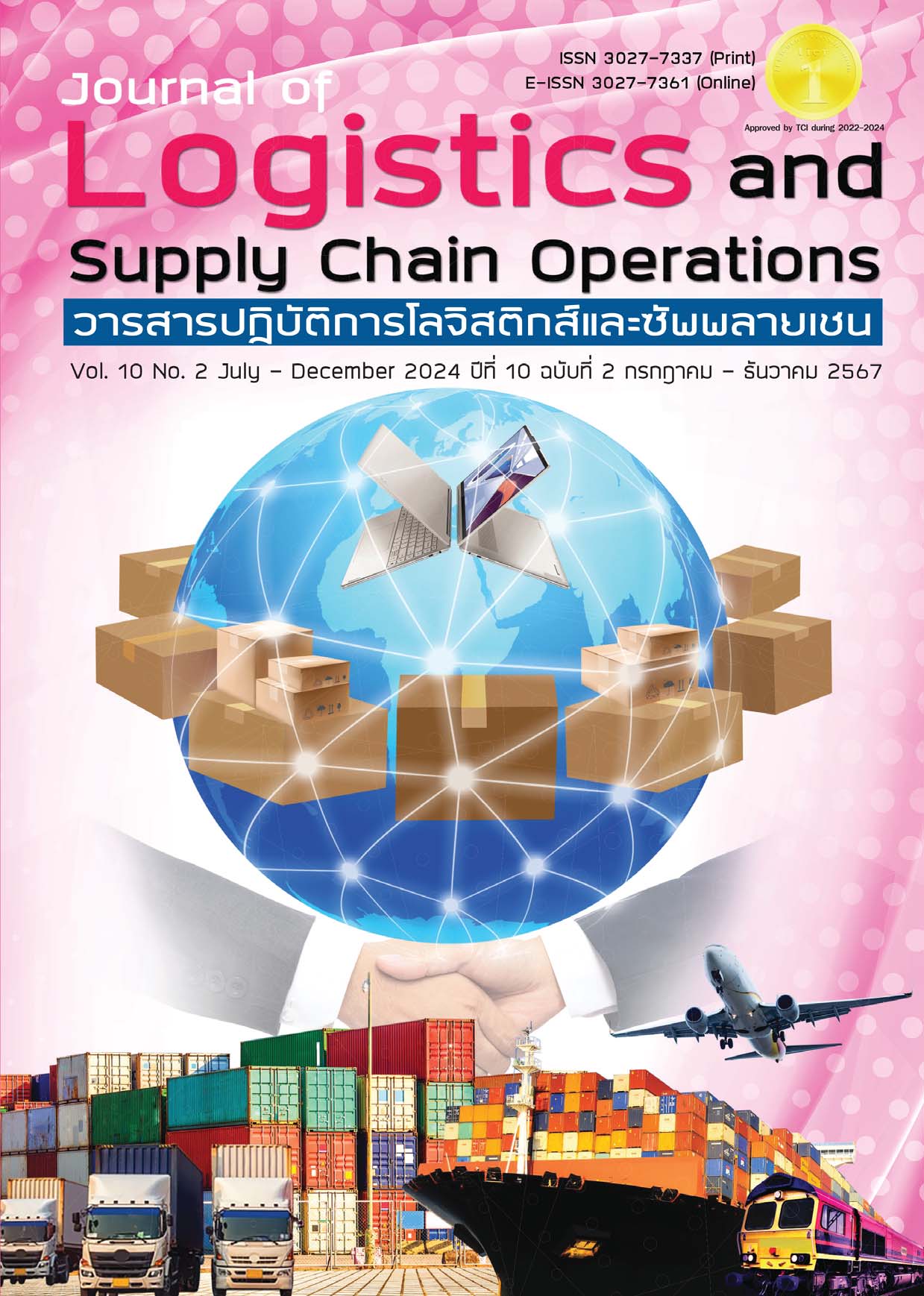Antecedents Affecting Performance of the Logistics Services Providers in Thailand
DOI:
https://doi.org/10.53848/jlsco.v10i2.267259Keywords:
Firm innovation, Employee engagement, Green logistics management, Brand equity, Firm performanceAbstract
The research aimed to 1) study levels of firm innovation, employee engagement, green logistics management, brand equity and firm performance, 2) study causal relationship of firm innovation, employee engagement, green logistics management and brand equity which influenced on performance of the Logistics Services Providers in Thailand, and 3) examine the accordance of casual relationship between the antecedents affecting performance of the Logistics Services Providers in Thailand and the empirical data. Data were collected from 303 primary level managers and the higher of the Logistics Services Providers in Thailand by questionnaire as a research instrument. The analytical data were conducted by using a structural equation model (SEM). The results showed that the average opinion of employee engagement and brand equity were the highest levels and the average opinion of firm innovation, green logistics management and firm performance were high levels. The structural equation model was completely compatible with empirical data and hypothesis: χ2/df = 1.307 p =0.078,CFI =0.995, TLI =0.990, GFI =0.973, RMSEA =0.032 RMR =0.014. The findings showed that firm innovation and brand equity had directly affected firm performance at a significance level of .001. The employee engagement and green logistics management had directly affected firm performance at a significance level of .01. Furthermore, firm innovation, employee engagement and green logistics management had also indirectly affected firm performance via brand equity at a significance level of .001.
References
กรมพัฒนาธุรกิจการค้า. (2565). รายชื่อธุรกิจให้บริการโลจิสติกส์ที่ผ่านเกณฑ์มาตรฐาน ISO 2001. ค้นเมื่อ 9 มิถุนายน 2565, จาก: https://www.dbd.go.th/more_news.php?cid=1667.
ธนิต โสรัตน์. (2552). โลจิสติกส์เพื่อสิ่งแวดล้อม. ค้นเมื่อ 9 มิถุนายน 2565, จาก: http://www. tanitsorat.com/view.php?id=352.
ธานินทร์ ศิลป์จารุ. (2560). การวิจัยและวิเคราะห์ข้อมูลทางสถิติด้วย SPSS และ AMOS. พิมพ์ครั้งที่ 17. นนทบุรี: เอสอาร์พริ้นติ้งแมสโปรดักส์.
บุญชม ศรีสะอาด. (2553). การวิจัยเบื้องต้น. พิมพ์ครั้งที่ 8. กรุงเทพฯ: สุวิริยาสาส์น.
พิชัย เหลี่ยวเรืองรัตน์. (2558). โลจิสติกส์สีเขียวเพื่อการพัฒนาที่ยั่งยืน. วารสารวิชาการมหาวิทยาลัยฟาร์อีสเทอร์น,8(2), 12-21.
ลดาวรรณ สว่างอารมณ์. (2560). ปัจจัยที่มีเหตุและผลของความร่วมมือในโซ่อุปทานที่มีต่อผลการดำเนินงานด้านโลจิสติกส์ธุรกิจนำเที่ยวในประเทศไทย. วิทยานิพนธ์ปริญญาดุษฏีบัณฑิต สาขาวิชาการจัดการโลจิสติกส์และโซ่อุปทาน. มหาวิทยาลัยศรีปทุม.
สำนักงานปลัดกระทรวงคมนาคม. (2564). ปริมาณการขนส่งภายในประเทศ. ค้นเมื่อ 15 สิงหาคม 2564, จาก: https://datagov.mot.go.th/dataset/freight-dom/resource.
สำนักงานสภาพัฒนาการเศรษฐกิจและสังคมแห่งชาติ. (2565). แผนพัฒนาเศรษฐกิจและสังคมแห่งชาติ ฉบับที่ 13 พ.ศ. 2566-2570. ค้นเมื่อ 9 กันยายน 2565, จาก: https://www.nesdc.go.th/main. php?filename=plan13.
Aaker, D. A. (1996). Measuring brand equity across products and markets. California Management Review, 38(3), 102-120.
Ajour El Zein, S., Consolacion-Segura, C., & Huertas-Garcia, R. (2020). The role of sustainability in brand equity value in the financial sector. Sustainability, 12(1), 254-272.
Bari, M. W., Abra, M., & Alaverdov, E. (Eds.). (2022). Antecedents and outcomes of employee-based brand equity. Hershey, PA: IGI Global.
Buchanan, B., II. (1974). Building organizational commitment: The socialization of managers in work organizations. Administrative Science Quarterly, 19(4), 533-546.
Choi, Y., & Zhang, N. (2011). Does proactive green logistics management improve performance? A case of Chinese logistics enterprises. African Journal of Business Management, 5(17), 7564-7574.
Devis, F. D., Goliac, L. S., & Marquardt, A. (2009). Measuring brand equity for logistics services. The International Logistics Management, 20(2), 201-212.
Drucker, P. F. (1994). Innovation and entrepreneurship: Practice and principle. London: Heinemann.
Geldes, C., Felzensztein, C., & Palacios-Fenech, J. (2017). Technological and non-technological innovations, performance and propensity to innovate across industries: The case of an emerging economy. Industrial Marketing Management, 61, 55-66.
Grant, D. B., Trautrims, A., & Wong, C. Y. (2017). Sustainable logistics and supply chain management: Principles and practices for sustainable operations and management. London: Kogan Page.
Hair, J. F., Black, W. C, Babin, B. J., & Anderson, R. E. (2010). Multivariate data analysis. 7th ed. New York: Pearson.
He, Q., Guaita-Martinez, J. M., & Botella-Carrubi, D. (2020). How brand equity affects firm productivity: The role of R&D and human capital. Economic Research, 33(1), 2976-2992.
Kalender, Z. T., & Vayvay, O. (2016). The fifth pillar of the balanced scorecard: Sustainability. Procedia - Social and Behavioral Sciences, 235, 76-83.
Kaplan, R. S., & Norton, D. P., (1996). Using the balanced scorecard as a strategic management system. Harvard Business Review, 74(1), 75-85.
Labafi, S., Salamzadeh, Y., & Jalalpoor, M. (2019). Green supply-chain management and green purchase intention, the role of green brand-equity. The Proceedings of ICBSI 2018 International Conference on Business Sustainability and Innovation, 3 August 2019 at Graduate School of Business, Universiti Sains Malaysia, Penang, Malaysia, 23-33.
Li, Z. (2022). How organizations create employee-based brand equity: Mediating effects of of employee empowerment. Frontiers in Psychology, 13, 862678. https://doi:10.3389/ fpsyg.2022.862678.
Liu, Y., Kim, C. Y., Lee, E. H., & Yoo, J. W. (2022). Relationship between sustainable management activities and financial performance: Mediating effects of non-financial performance and moderating effects of institutional. Sustainability, 14(3), 1168.
Mckinnon, A., Cullinane, S., Browne, M., & Whiteing, A. (2010). Green logistics: Improving the environmental of logistics. London: Kogan Page.
Mutie, M. D., Odock, S., & Litondo, K. (2020). Effect of green logistics on performance of logistics firm in Kenya. DBA Africa Management Review, 10(4), 20-35.
Nana, S., Tobias-Mamina, R. J., Chiliya, N., & Maziriri, E. T. (2019). The impact of corporate rebranding on brand equity and firm performance. Journal of Business and Retail Management Research, 13(4), 93-102.
Osman, Z., Samad, R. R. Alwi, N. H., & Khan, B. N. A. (2022). Direct and indirect relationship of employee engagement, corporate image, employee loyalty and business performance among private business organizations. International Journal of Academic Research in Economics and Management Sciences, 11(3), 483-498.
Schumacker, R. E., & Lomax, R. G., (2016). A beginner’s guide to structural equation modelling. 4th ed. New York: Taylor & Francis.
Seggie, S. H., Kim, D., & Cavusgil, S. T. (2006). Do supply chain IT alignment and supply chain interfirm system integration impact upon brand equity and firm performance? Journal of Business Research, 59(8), 887-895.
Singhry, H. B. (2015). Supply chain innovation and performance of manufacturing companies. International Journal of Business and Management Review, 3(10), 42-60.



